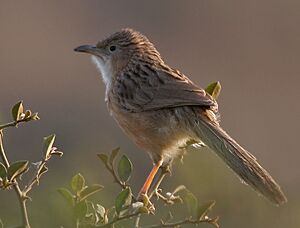Common babbler facts for kids
Quick facts for kids Common babbler |
|
|---|---|
 |
|
| T. c. caudata (Haryana, India) | |
| Conservation status | |
| Scientific classification | |
| Synonyms | |
|
Crateropus caudatus |
The common babbler (Argya caudata) is a small, social bird. It belongs to a bird family called Leiothrichidae. These birds live in dry, open areas, mostly in India. They are known for their long tails and brownish-grey feathers. You can often see streaks on their upper feathers and a clear whitish throat.
Scientists have identified two main groups of common babblers. Birds living west of the Indus River are now often seen as a separate species. This related bird is called the Afghan babbler (Turdoides huttoni).
Contents
About the Common Babbler
What Does a Common Babbler Look Like?
This bird is quite small and slim, with a very long tail. Its feathers are buff to grey on top, with dark streaks. The feathers on its belly are lighter and don't have streaks. Its throat is almost white.
How Scientists Name Babblers
Scientists group animals to understand them better. The common babbler was once in a group called Turdoides. After new studies in 2018, it was moved to an older group called Argya. The name caudata means "tailed" and fits the new group's name.
There are different types of common babblers. One type, eclipes, lives from northern Pakistan to northwestern India. The other type, caudata, is found in southern Pakistan, Nepal, Bangladesh, and India. This includes the Lakshadweep Islands.
Babbler Life and Habits
Living in Groups
Like many other babblers, common babblers live in small groups. These groups usually have six to twenty birds. They are quite noisy and often move around on the ground. Some group members will watch for danger from the tops of bushes.
They look for food in the low plants. They hop on the ground and sometimes move like small animals. When they walk, they often hold their long tails up high.
Babbler Sounds and Food
Common bablers make a quick, chattering sound like which-which-whichi-ri-ri-ri-ri. If they sense danger, they make a loud, high-pitched squeak.
These birds mostly live in dry areas with thorny bushes and not many tall trees. They eat insects, berries, and grains. Some of their favorite berries come from Lantana and Capparis plants.
Family Life and Nesting
Several pairs of babblers in a group might have babies at the same time. Adult babblers often help clean the head and neck feathers of other birds in their group.
In India, they usually build nests in the summer, from May to July. There are two busy nesting times, with a break during the rainy season. They build a shallow, cup-shaped nest low in a thorny bush. They lay about 2 or 3 turquoise blue eggs. In northern India, they sometimes use piles of cut Zizyphus branches for nesting.
The eggs hatch after about 13 to 15 days. Sometimes, their nests are taken over by other birds, like the Jacobin cuckoo or the common hawk-cuckoo. Young babblers can fly after about a week. They stay with their group and join the adults when they rest at night.
Helpers at the Nest
Older young birds from a previous brood might help the parents. They feed the female who is sitting on the eggs and also help feed the baby birds. When a bird brings food, it often hops, makes a soft chattering sound, and shivers its feathers.
Young babblers have yellow mouths, and their eye color changes from light brown to dark brown as they grow. They all rest together as a group. Scientists believe that male babblers in a group are often related. Female babblers usually leave their birth groups to join new ones.
Images for kids





